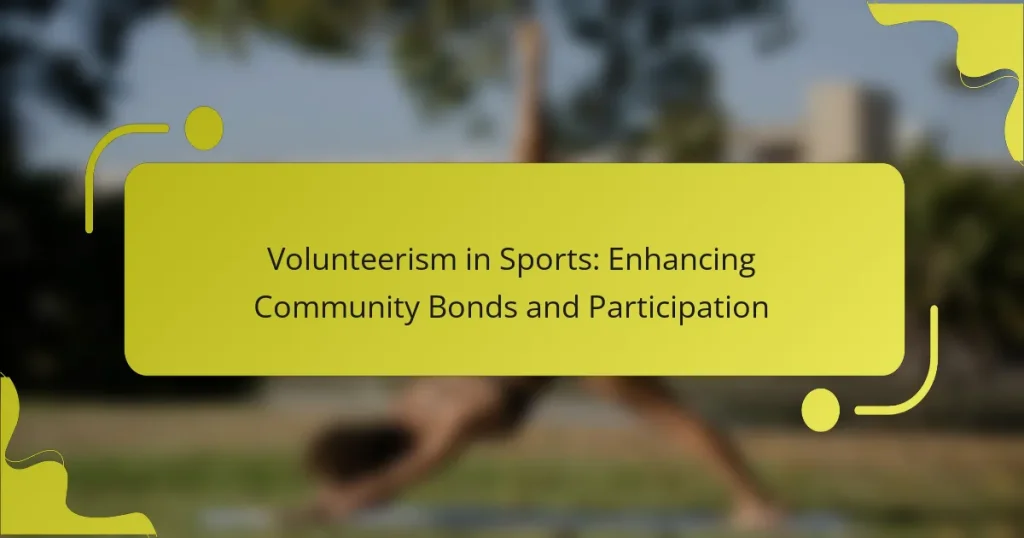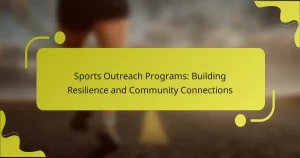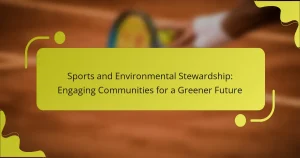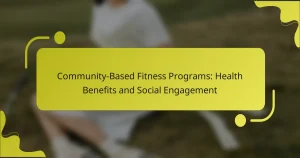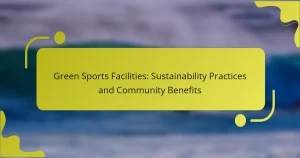Volunteerism in sports enhances community bonds by fostering collaboration and trust. It supports youth development through teamwork and leadership skills. Innovative strategies, such as community events and digital platforms, increase participation and engagement. Measuring impact through surveys and feedback helps evaluate the effectiveness of these initiatives.
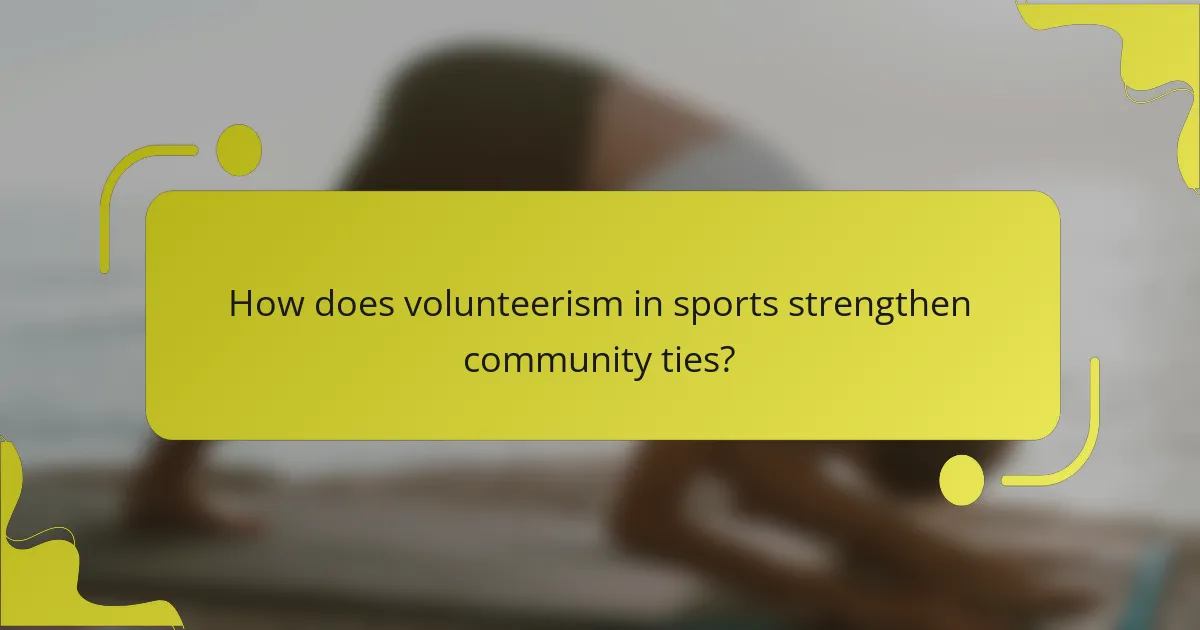
How does volunteerism in sports strengthen community ties?
Volunteerism in sports strengthens community ties by fostering collaboration, building trust, and enhancing social networks. It encourages local engagement and participation, leading to a sense of belonging. For example, community sports events often rely on volunteers, creating shared experiences that unite diverse groups. As a result, volunteerism cultivates lasting relationships and a supportive environment within the community.
What are the key benefits of engaging in sports volunteerism?
Engaging in sports volunteerism offers numerous benefits, including community bonding, skill development, and increased participation. Volunteers foster connections among diverse groups, enhancing social cohesion. They also gain valuable experience, improving leadership and teamwork skills. Additionally, sports volunteerism encourages a culture of active living, promoting healthier lifestyles within the community.
Which communities benefit the most from sports volunteer programs?
Communities with limited resources, youth programs, and health initiatives benefit the most from sports volunteer programs. These programs enhance local engagement, promote teamwork, and provide essential support. For example, underprivileged neighbourhoods often see improved access to sports activities, fostering social connections and personal development. Additionally, schools benefit by integrating volunteers to coach and mentor students, leading to increased participation and skill development.
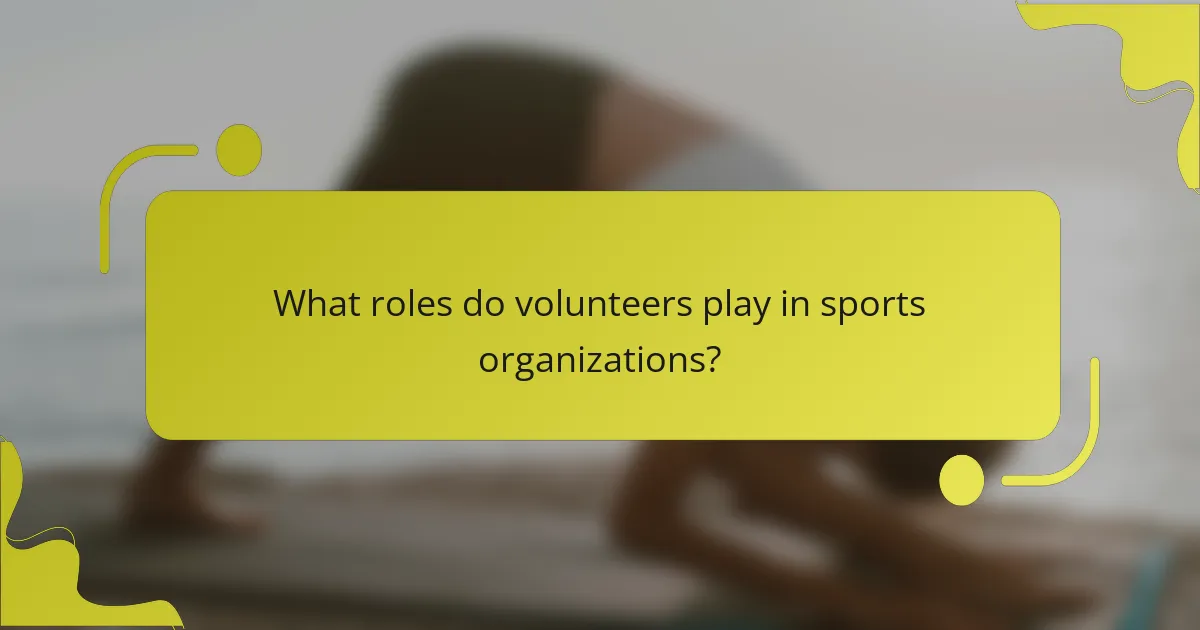
What roles do volunteers play in sports organizations?
Volunteers play crucial roles in sports organizations by fostering community engagement and enhancing participation. They support events, manage logistics, and promote inclusivity. Volunteers also serve as mentors, helping to develop skills among participants. Their contributions strengthen community ties and create a welcoming environment for all.
How do volunteers enhance event organization and execution?
Volunteers significantly enhance event organization and execution by providing essential support and fostering community engagement. They contribute diverse skills, from logistics to customer service, improving overall event quality. Volunteers create a sense of belonging, encouraging local participation and strengthening community bonds. Their involvement often leads to increased attendance and satisfaction, vital for the event’s success.
What skills can volunteers develop through sports involvement?
Volunteers can develop skills such as teamwork, leadership, communication, and problem-solving through sports involvement. These experiences enhance personal growth and community engagement.
Teamwork is fostered as volunteers collaborate with diverse groups. Leadership skills emerge when taking initiative in organizing events or guiding participants. Effective communication is vital for conveying instructions and building relationships. Problem-solving abilities are sharpened when addressing challenges in dynamic environments.
Engaging in sports volunteerism not only benefits individuals but strengthens community bonds and promotes active participation.
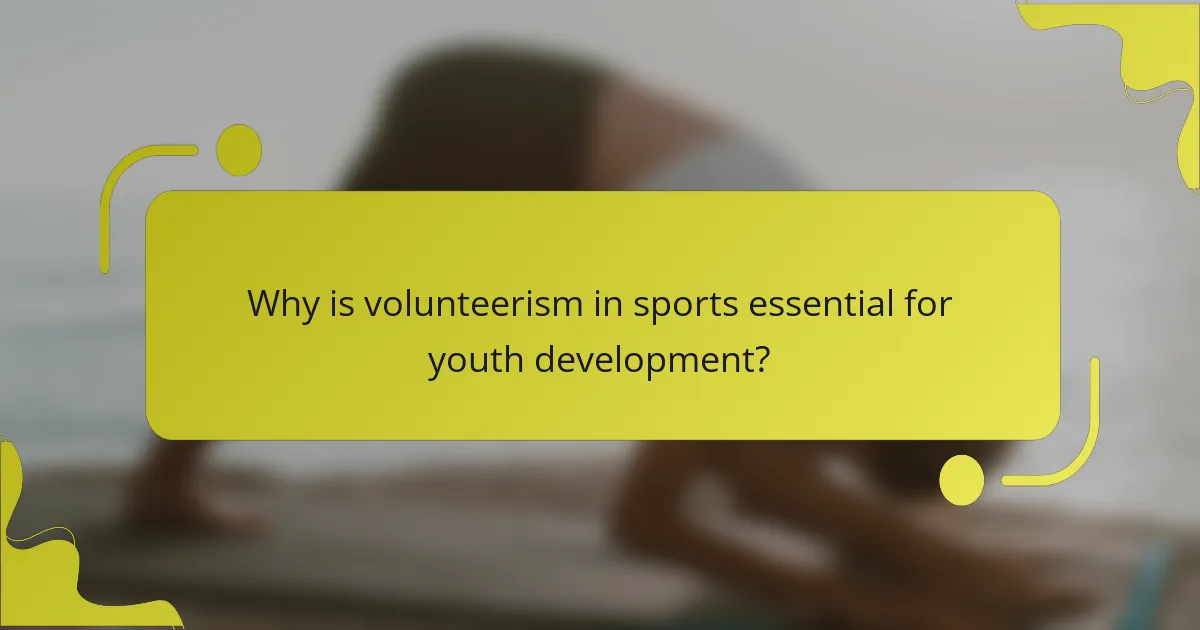
Why is volunteerism in sports essential for youth development?
Volunteerism in sports is essential for youth development as it fosters teamwork, leadership, and social skills. Engaging in volunteer activities helps young people build community bonds and enhance their sense of belonging. Studies show that youth involved in sports volunteerism are more likely to develop positive relationships and improve their self-esteem. Additionally, volunteerism provides practical experience, teaching valuable life skills like responsibility and commitment. This involvement also promotes physical health and encourages lifelong participation in community activities.
How does participation in sports volunteering impact youth character building?
Participation in sports volunteering significantly enhances youth character building. Engaging in volunteer activities fosters teamwork, responsibility, and leadership skills among young individuals.
Youth involved in sports volunteering often develop empathy and social awareness, as they work with diverse groups and contribute to community well-being. Studies show that 78% of youth volunteers report improved self-esteem and confidence, stemming from their contributions.
Additionally, sports volunteering provides opportunities for personal growth through challenges and successes. These experiences help youth build resilience, an essential trait for overcoming obstacles in various life aspects.
Overall, sports volunteerism serves as a powerful tool for character development, shaping well-rounded individuals who positively impact their communities.
Which unique programs foster youth engagement through sports volunteerism?
Unique programs that foster youth engagement through sports volunteerism include initiatives like “Youth Sports Leaders,” “Play It Forward,” and “Coaching Corps.” These programs empower young people by integrating sports with community service, enhancing leadership skills and social responsibility. For instance, “Youth Sports Leaders” trains youth to mentor younger athletes, fostering a sense of community and belonging. “Play It Forward” encourages participants to volunteer in local sports events, promoting teamwork and civic engagement. “Coaching Corps” connects youth with coaching opportunities, providing valuable life skills while addressing community needs. These initiatives exemplify how sports can be a vehicle for positive community impact.
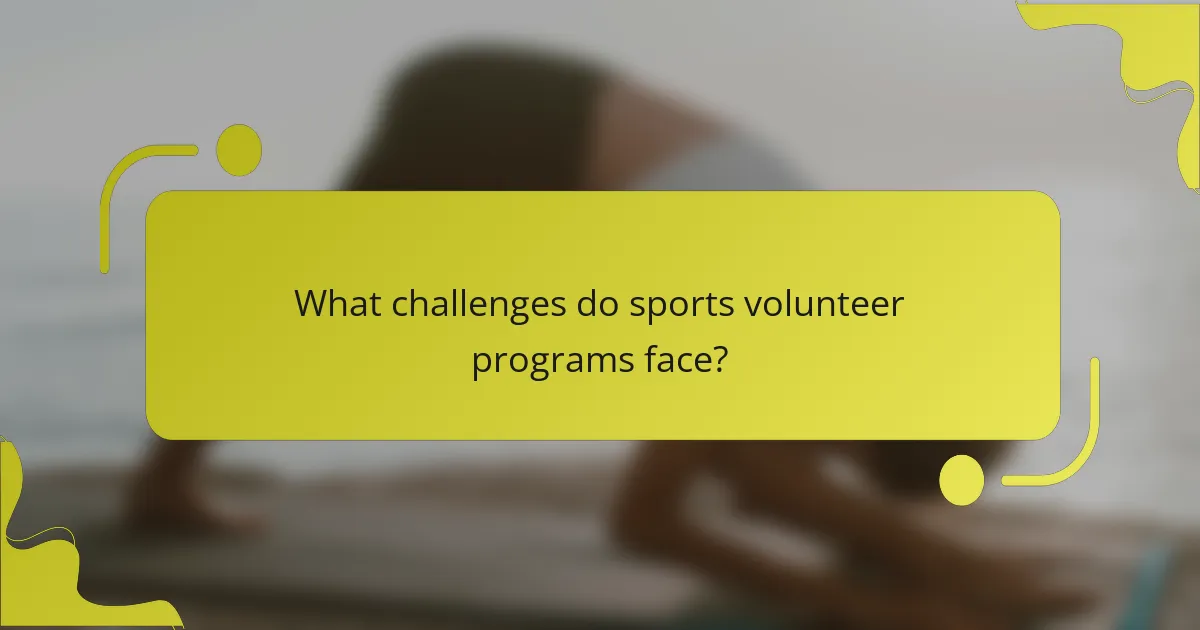
What challenges do sports volunteer programs face?
Sports volunteer programs face challenges such as recruitment, retention, and resource allocation. These issues hinder the effectiveness of initiatives aimed at enhancing community bonds. Limited funding often restricts outreach efforts, making it difficult to attract a diverse volunteer base. Additionally, volunteers may experience burnout due to high expectations and insufficient support. Communication gaps between organizers and volunteers can further exacerbate these challenges, leading to misunderstandings and decreased participation. Addressing these obstacles is crucial for fostering a sustainable volunteer culture in sports.
How can organizations overcome common barriers to volunteer recruitment?
Organizations can overcome barriers to volunteer recruitment by fostering a welcoming environment and enhancing communication. First, they should identify common obstacles, such as lack of awareness or perceived time constraints. Creating flexible opportunities allows potential volunteers to engage without overwhelming commitments. Additionally, promoting the positive impact of volunteerism in sports can attract individuals by highlighting community benefits and personal growth. Engaging current volunteers as ambassadors can also create a sense of trust and authenticity, motivating others to participate.
What are the implications of volunteer burnout in sports?
Volunteer burnout in sports can lead to reduced participation and weakened community ties. It affects the sustainability of volunteer programs and the overall effectiveness of sports organizations. High turnover rates among volunteers can disrupt event planning and diminish the quality of experiences offered. As a result, organizations may struggle to maintain engagement and support within the community, ultimately impacting the success of sports initiatives. Addressing volunteer burnout is crucial for fostering long-term commitment and enhancing community bonds.
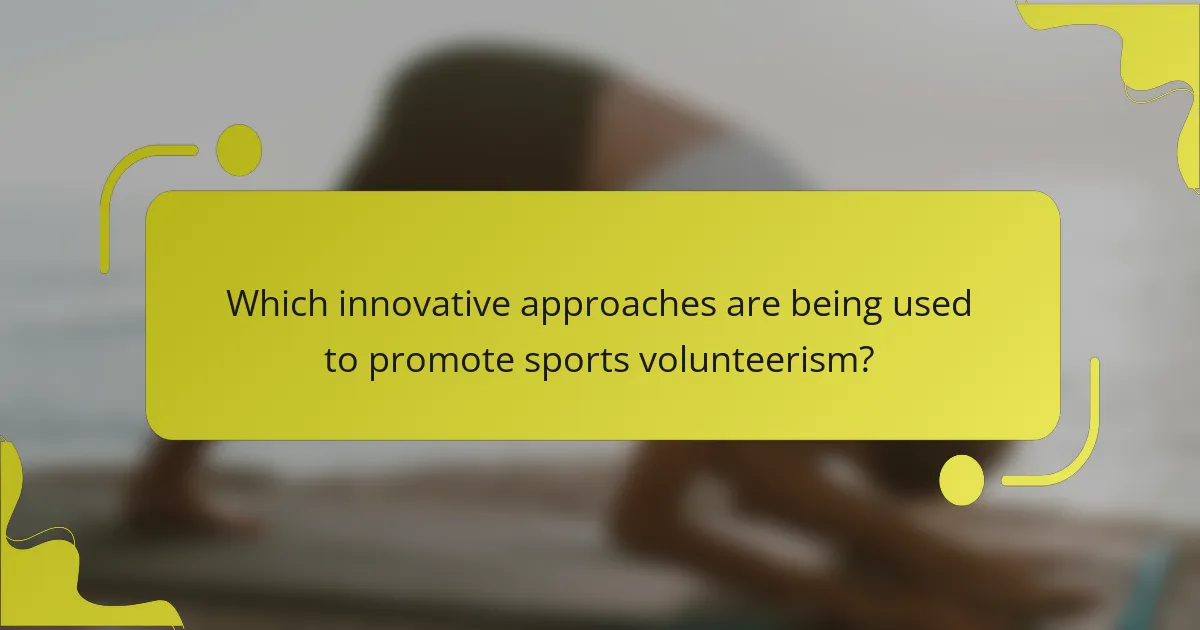
Which innovative approaches are being used to promote sports volunteerism?
Innovative approaches to promote sports volunteerism include engaging community events, digital platforms, and partnerships with local organizations. These strategies foster connections and enhance participation.
Community events such as sports festivals and volunteer fairs create opportunities for direct engagement. Digital platforms leverage social media and apps to connect volunteers with sporting events, making it easier to sign up and participate. Collaborations with local organizations amplify outreach and resources, encouraging broader community involvement.
As a result, these approaches not only increase volunteer numbers but also strengthen community bonds through shared experiences in sports.
How do technology and social media facilitate volunteer engagement?
Technology and social media enhance volunteer engagement by streamlining communication and expanding outreach. Platforms like Facebook and Twitter connect volunteers with organizations, facilitating real-time updates and event coordination. Online tools simplify the registration process, making it easier for individuals to join initiatives. Additionally, social media campaigns raise awareness, attracting diverse participants and fostering a sense of community. Data shows that organizations utilizing these platforms often see increased volunteer retention rates, strengthening community bonds.
What are some successful case studies in sports volunteerism?
Successful case studies in sports volunteerism demonstrate significant community impact and engagement. One notable example is the 2016 Rio Olympics, where over 70,000 volunteers enhanced the event’s operations, promoting local culture and fostering community pride. Another case is the NFL’s Play 60 initiative, which encourages youth volunteerism through physical activity, resulting in over 1.5 million volunteer hours logged by participants. Additionally, local marathons often rely on volunteers for logistics, creating a sense of belonging and teamwork among community members. These case studies illustrate how sports volunteerism strengthens community bonds and increases participation.
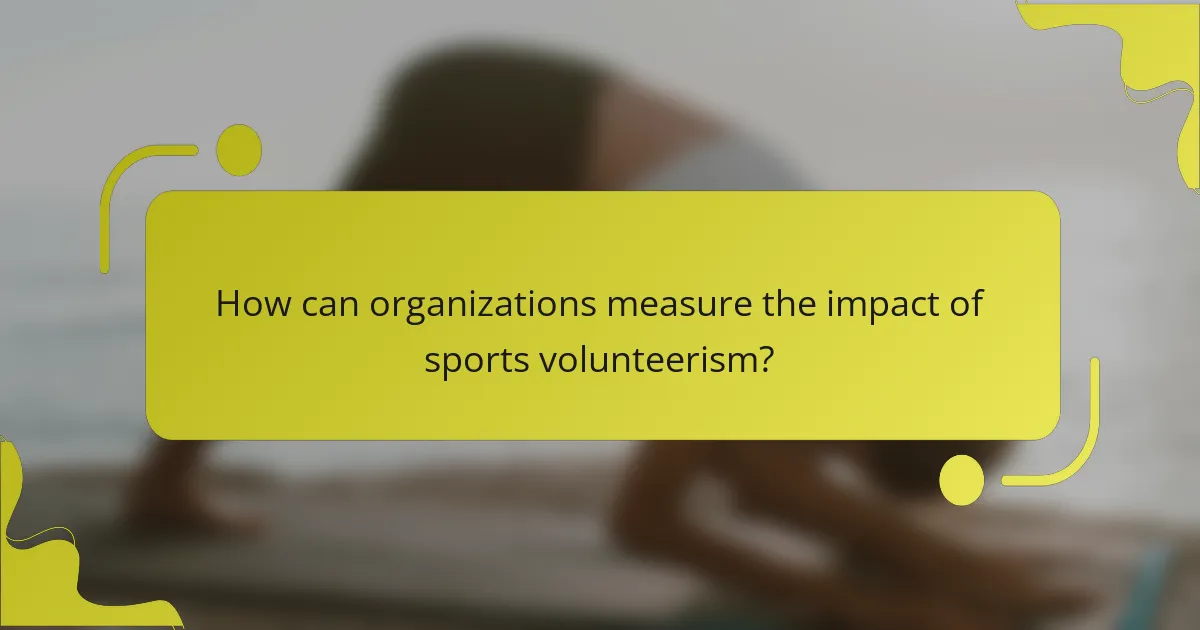
How can organizations measure the impact of sports volunteerism?
Organizations can measure the impact of sports volunteerism through surveys, participation metrics, and community feedback. Surveys can assess volunteer satisfaction and community perceptions. Tracking participation rates reveals engagement levels and the breadth of volunteer efforts. Community feedback highlights qualitative impacts, such as strengthened relationships and enhanced local spirit. Evaluating these metrics provides a comprehensive view of volunteerism’s effectiveness in fostering community bonds.
What metrics are most effective in assessing volunteer contributions?
Effective metrics for assessing volunteer contributions in sports include participation rates, hours volunteered, impact on community engagement, participant satisfaction, skill development, and retention rates. These metrics provide insight into the effectiveness of volunteer programs and their role in enhancing community bonds.
Which success stories highlight the outcomes of sports volunteerism?
Volunteerism in sports leads to significant positive outcomes for communities. Success stories illustrate enhanced community bonds, increased participation, and improved local infrastructure.
One notable example is the “Youth Sports Volunteer Program” in Chicago, which engaged over 2,000 volunteers. This initiative resulted in a 30% increase in youth participation in sports activities, fostering teamwork and social skills among participants.
Another impactful case is the “Sports for All” campaign in Sydney, where volunteers organized local events. This effort not only brought together diverse community members but also raised funds for underprivileged youth, demonstrating how volunteerism can drive social change.
In addition, the “Green Sports Alliance” in the U.S. showcases how sports volunteers contribute to sustainability efforts, resulting in a 25% reduction in waste at major sporting events. These stories highlight the transformative power of sports volunteerism in building stronger communities.
What best practices can enhance the effectiveness of sports volunteer programs?
To enhance the effectiveness of sports volunteer programs, focus on clear communication, training, and community engagement. Establish defined roles for volunteers to ensure accountability. Provide comprehensive training to equip volunteers with necessary skills. Foster community engagement through outreach and collaboration with local organizations. Regular feedback and recognition can also boost volunteer morale and retention.
